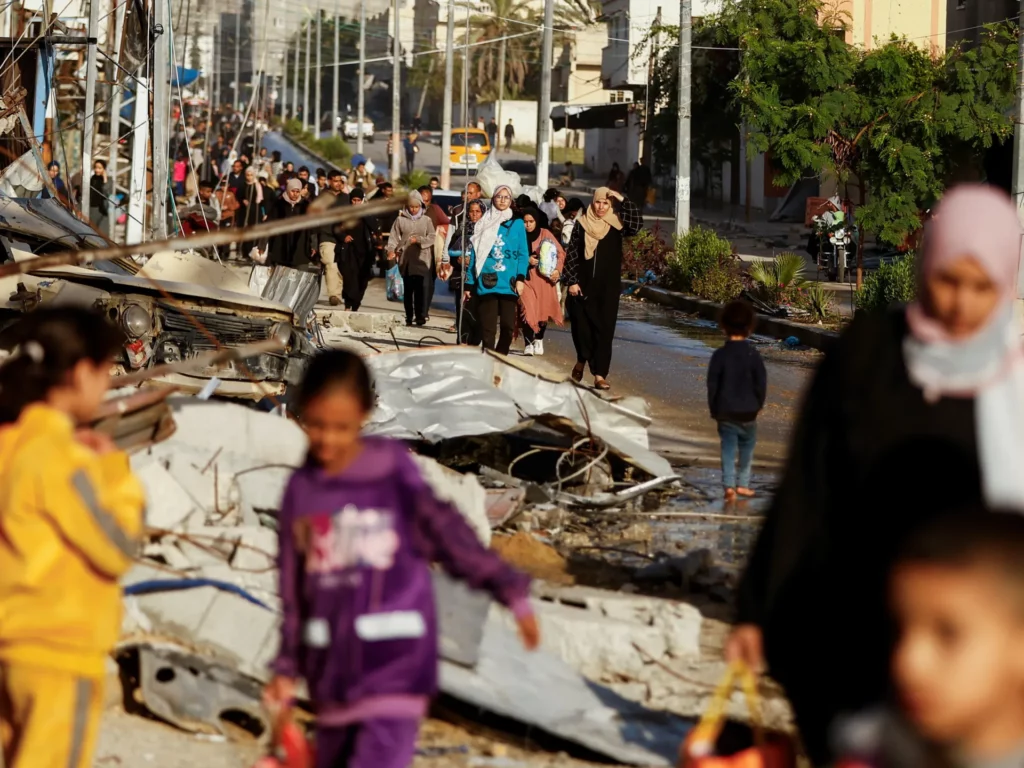At 7 AM Friday morning, the agreed-upon four-day truce began in expectedly disappointing fashion.
In the very first hours of the truce, the Israeli army opened fire around the Al-Rantisi hospital in an attempt to stop people from returning to their houses. In doing so, Israel has effectively broken the agreement’s provision on non-obstructing people’s freedom of movement.
The truce’s provisions included a ceasefire from both sides, the intensification of the entry of humanitarian aid, relief, medical and fuel trucks to the Gaza Strip, the release of 50 Israeli hostages and 150 Palestinian prisoners under the age of 19, along with the cessation of air movements and the guarantee of people’s freedom of movement and its non-obstruction, especially on the Salah El-Din Street where people cross from north to south Gaza.
The spokesperson of the Rafah Crossing Administration announced that aid and fuel trucks have started entering the Gaza Strip in expectation of 230 trucks per day. In spite of this slight improvement, the trucks that have entered the strip are transporting only a fifth of the supplies that were entering daily.
Pre- and Post-Ceasefire Violations
Similarly to previous ceasefire agreements – which were also violated – Israeli forces launched a massive bombing campaign on Gazan residential areas in the hours preceding the beginning of the temporary truce.
Israeli forces bombed and broke into the Indonesian Hospital in northern Gaza a few hours, and minutes, before the ceasefire was put into effect. They raided the hospital and targeted the hospital’s power generators and main resources, killing one woman and wounding three others in the process.
Israeli forces also bombed the facilities of Al-Shifa hospital’s compound, including electricity generators, oxygen pumps and x-ray machines. This was done under the guise that they had found tunnels utilized by Hamas under the hospital, but it has been repeatedly proven that the tunnels were built in 1983, when Israel still had control of the strip.
An article by The Intercept found that “during the construction at Al-Shifa in the 1980s, the Israeli construction contractors hired Hamas to provide security guards to prevent attacks on the building site.”
“You know, decades ago we were running the place, so we helped them — it was decades, many decades ago, probably four decades ago that we helped them to build these bunkers in order to enable more space for the operation of the hospital within the very limited size of this compound,” former Israeli Prime Minister Ehud Barak told a visibly stunned CNN host Christiane Amanpour.
Moving Ahead
Many organizations have considered the ceasefire agreement and the release of hostages and Palestinian prisoners and detainees to be the first step towards a sustainable ceasefire and the lifting of the siege on Gaza.
On his part, Secretary General of the Islamic Jihad Movement Ziad Nakhaleh said that Israeli captives will not be released until all Palestinian prisoners are as well. Nakhaleh adds that Israel wouldn’t have accepted the ceasefire deal were it not for the losses it incurred on an individual and machine level.
He asserts that, with the steadfastness of the fighters on the ground, they will force Israel to accept a big exchange operation, reconstruction obligations and other political conditions that will open up important horizons for the Palestinian population and its freedom.
So far, the aid delivered to Gaza before the ceasefire and during its first few hours have been far from sufficient to meet the minimum basic needs of affected Palestinians.
With Israeli forces already violating ceasefire agreement provisions and showing no signs of stopping their genocidal aggressions anytime soon, much remains to be done to end the current onslaught, provide Palestinian with long-absent justice and punish Israeli forces, settlers and government officials for their countless human rights violations.
